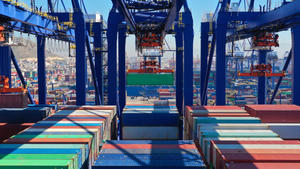The supply chain certainly wasn’t in need of any additional complications, but nearly a week of blockades at a pivotal U.S.–Canadian border crossing have added to an already distressed system.
Beginning February 7, thousands of truckers angry about the mandatory vaccination of truck drivers crossing the border all but shut down the Ambassador Bridge, which connects Michigan and Canada. The closure of the bridge, which carries more than one-fourth of the trade between the two countries, has affected an estimated $392.56 million a day in cross-border transactions. On February 14, Canadian authorities managed to clear the blockades, an effort that resulted in 25 to 30 arrests and the seizure of five vehicles. Canadian Prime Minister Justin Trudeau even declared a national emergency in a bid to end the protests.
While the auto industry is likely to feel the brunt of the blockades effects—the blocked route primarily sees the import of steel, aluminum and other parts crucial to the Michigan-based auto industry, with an estimated $140 million of car parts and vehicles generally exchanged via the Ambassador Bridge every day—Canadian furniture manufacturers are also likely to feel an impact. “Canadian manufacturers in the home sector are experiencing all the pains of the supply chain that we’re having in the U.S., so this was just another kick in the teeth,” says Ray Allegrezza, executive director of the International Home Furnishings Representatives Association.
The weeklong blockade joins two other major issues still engulfing the global supply chain: congestion at ports and the cost of shipping containers.
President Biden announced in October that the Ports of Long Beach and Los Angeles, which process roughly 40 percent of container shipments coming through the U.S., would operate 24 hours a day, seven days a week to deal with the backlog of ships waiting off the coast, but the change has yet to happen. Allegrezza attributes the lack of progress at the two ports to an intersecting crisis: the American labor shortage. “There’s a shortage of dock workers to unload the ships and a shortage of truck drivers to pick up the cargo once it is finally unloaded,” says Allegrezza. Currently, there are 78 container ships in the queue—which is, perhaps surprisingly, an improvement from 109 a month ago, according to the Marine Exchange of Southern California.
In an annual state-of-the-port address given on February 9, Port of Long Beach executive director Mario Cordero said 24/7 operations are still the goal, but outlined no specific timeline to make the change occur. “Here at the Port of Long Beach, we continue to work to clear backlogs of vessels offshore, which assures that we’ll remain moderately busy into the spring,” said Cordero. “Still, given our historic volumes in the first half of 2021, we’ll be hard pressed to see more than slow gains until perhaps the fall.”
Meanwhile, the cost of using those shipping containers languishing off coastlines has yet to return to pre-pandemic levels. As recently as last week, both container shipping group Maersk, which handles about one in five containers shipped worldwide, and freight forwarder DSV warned that freight costs were likely to remain high into late 2022. It’s a situation that Allegrezza says could impact small to midsize furniture companies the hardest, with big box stores more able to pay the increased cost and negotiate better deals with shipping companies.
It’s a point of view echoed by Maersk CEO Søren Skou, who in a press conference from the company’s Copenhagen headquarters last week said high shipping costs prompted more customers to seek longer-term contracts instead of relying on securing container capacity in the spot market. “In the extraordinary market situation last year, we’ve had to prioritize customers who sought a longer-term relation with us,” said Skou. Maersk expects an operating profit of around $24 billion this year.
While Skou and Cordero point to a return to a semblance of normalcy by the fall, Allegrezza is not as certain. “With COVID and its variants still presenting major issues, there’s an industry-wide struggle to give a realistic forecast for when this might ease up,” he says. “The supply chain didn’t get itself this tangled overnight, and it won’t be fixed overnight either.”
Homepage photo: © hit1912/Adobe Stock



























